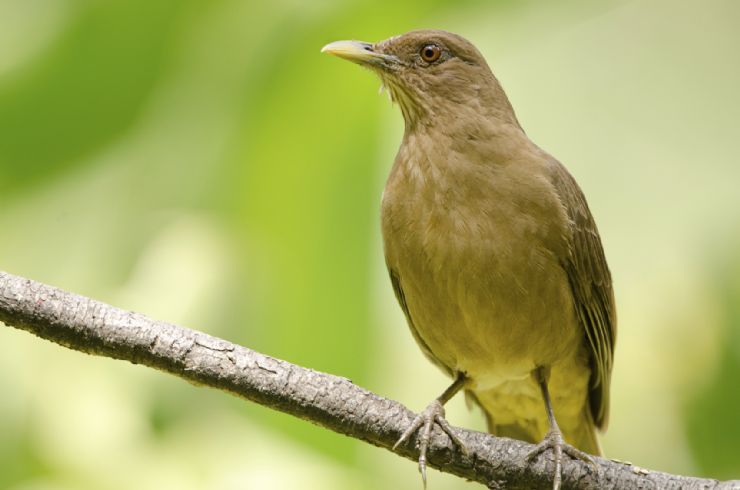
Costa Ricas national bird, Clay-colored Thrush
I love showing visitors all that Costa Rica offers, from colorful beaches and surfing spots to tropical rainforests and rare species. My tiny homeland has all of those things and more. I share this country with a rich and diverse collection of animals and plants, which tour groups from all over the world tell me is why they visit.
Today, we’re going to visit five of the best spots for Costa Rica birdwatching. We have more than 600 resident avian species and more than 200 migratory species. From colorful toucans in the forest to the magnificent frigatebird off the beaches, our bird population is pretty diverse, no matter what time of year you visit. You’ll have to pardon me if I need to duck under a leaf now and then. I am prey for these guys, after all. Ready? Then, we’re off.
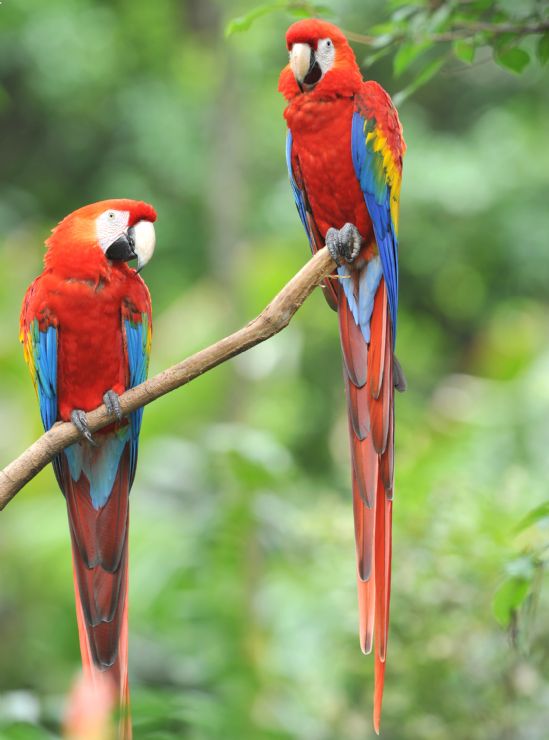
A pair of Scarlet Macaws (Ara macao) in Palo Verde National
1. Palo Verde National Park
7 Days / 6 Nights
Starting at $779 per person
Located south of Bagaces, Palo Verde is a good place to start because it offers a variety of natural bird habitats, including wetlands, grasslands and a dry forest. The Rio Tempisque runs through here. During the rainy fall season it floods, creating a broad marsh area that attracts many migrating birds. All that water makes it harder for people to get around, but you’ll see some beautiful birds here, including snowy white herons, roseate spoonbills and green-backed herons. Also look for great egrets, glossy ibis, black-bellied whistling ducks and blue-winged teals.
My favorite is the scarlet macaw, who lives in the forest. He’s as colorful as a piñata, with bright red, yellow and blue feathers. I hope we get to see the three-wattled bellbird; he looks a little funny with those long wattles off his bill, but if you’re here during spring, you might hear his piercing call. Other animals you may see around here include monkeys, iguanas and crocodiles.
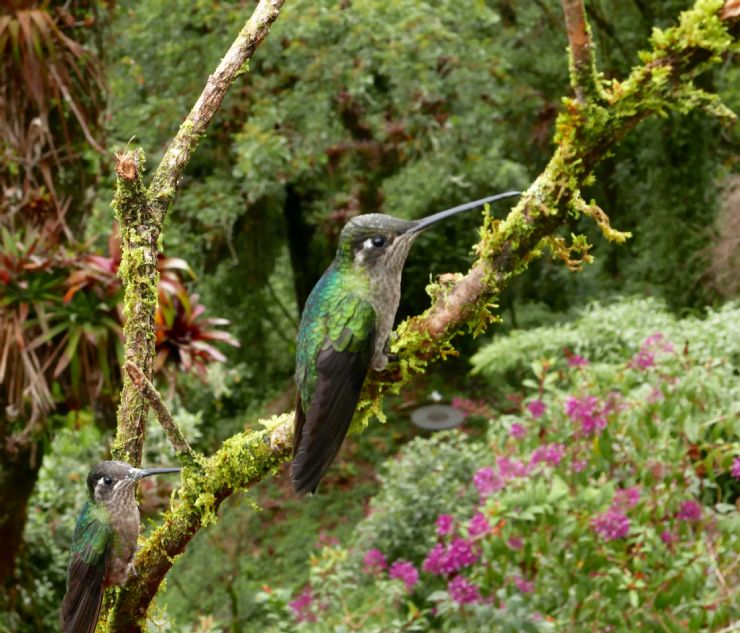
Beautiful Hummingbird at Monteverde Cloud Forest Reserve
2. Monteverde Cloud Forest Reserve
You’ve got to see Costa Rica cloud forests and Monteverde is a MUST if you're traveling to the Pura Vida country. The reserve is like New York City, where you will find at least two of everything. It’s packed; don’t even try to get around during rush hour. All types of cats and other animals live here: jaguars, monkeys, tapir, sloth and lots of toads, snakes and amazing colorful frogs like me. There are many varieties of plants, such as orchids, ferns, lichens and more; they love the mist that hangs out up here (they call it a cloud, but it’s mist made by the high temperatures up here above the sea).
Of course, you’re here for Costa Rica birds, and there are plenty. Did you see that one that just buzzed by us? I think it was a ruby-throated hummingbird, one of 30 different hummingbirds here. Some of them include parrots, the brown pelican, herons, eagles, cuckoos, owls, blue-throated toucanet and more, more, more. If we’re lucky, we may see the Resplendent Quetzalgreat or maybe the curassow, whose population is endangered. This bird is more than three feet tall and glossy black, with dark blue undertones and a bright yellow bill. The female looks more like a pheasant, with black tail feathers accented in white.
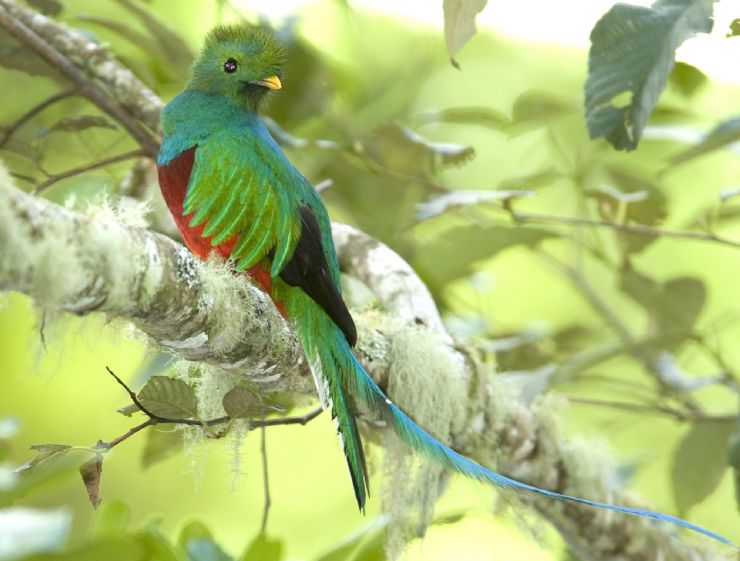
Male Quetzal spotted in Los Quetzales National Park
3. Los Quetzales National Park
Another mountain park, Los Quetzales stretches across three rainforests and boasts a glacier in the background. That contrast should tell you something about the diversity of this park. I have counted up to 14 ecosystems here and animals that include pumas, black guans, tapirs and squirrel monkeys.
Our most famous resident is the amazing Quetzal, who loves to show off during mating season. This guy has sparkling green or red feathers and a streaming tail that, by itself, can measure up to three feet long. Chicks dig it, and I must say, it’s pretty impressive (don’t tell him I said that. His head is big enough already having the park named after him). There are colorful hummingbirds here too. You’d be amazed at the beautiful shades of their feathers, from shiny blues and purples to greens and yellows. Look for their tiny, cone-shaped nests among the foliage.
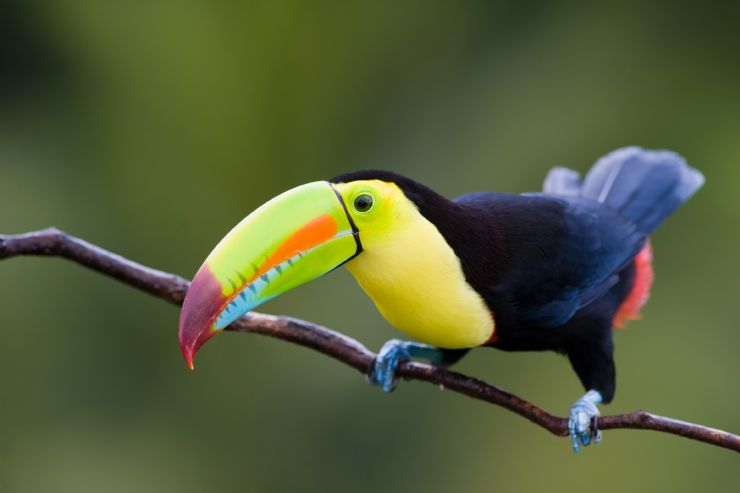
Keel Billed Toucan preparing to fly on forest
4. Santa Rosa National Park
I like to take people to Santa Rosa because it’s got something you won’t find anywhere else: 10 different habitats, including woodlands, forests and marshlands. Maybe that’s why there are so many animals here, from turtles to coatimundi, deer and jaguar. I have a lot of cousins who live around here somewhere, along with plenty of toads and salamanders. During the dry season, the foliage shrinks back to reveal some awesome beaches (surfers love the water here) and there is an incredible selection of bugs. I still haven’t tried them all, but I look for new ones to eat whenever I’m in the area. There are about 10,000 insect species here, more than enough to feed the 250 bird species.
The star of this park is the keel-billed toucan, whose body is black with a yellow breast and the most colorful bill anywhere. It’s a bright green with splashes of turquoise and orange leading to a tip covered in purple. If you have a good view, you’ll see his scarlet bottom and turquoise talons. Other Costa Rica birds in this park are the great curassow, yellow-breasted trogons, and motmots.
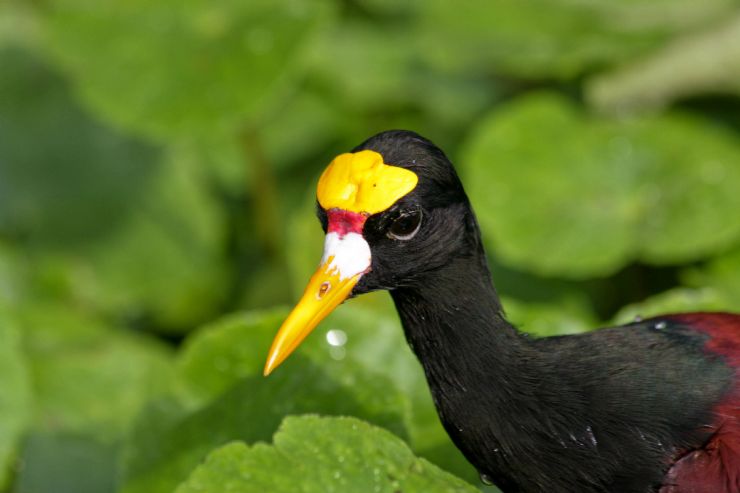
Northern Jacana in Caño Negro Wildlife Refuge
5. Caño Negro National Wildlife Refuge
Our last stop is the site of an important wetland and home to several rare species of birds, plants and animals. This area is humid and sees a lot of migratory northern birds during the rainy season. Cougars, ocelots, the mantled howler monkey and peccary (a type of pig) are found here.
Caño Negro is the only place in Costa Rica where you can find the rare Nicaraguan grackle, a glossy black bird with a beautiful fan of tail feathers. The feathers have a faint turquoise sheen on the male’s chest, head and back and a faint purple sheen on the rest of his body. Females are brown with a beige underbelly. Other birds you’ll find here include the wood stork, Northern Jacana, green-backed heron, black-necked stilt and glossy ibis.
This refuge is the perfect end to a fun day of Costa Rica bird watching. You’re invited back any time. If you have any questions about my country and its many attractions, contact us here at Go Visit Costa Rica, Pura Vida!

